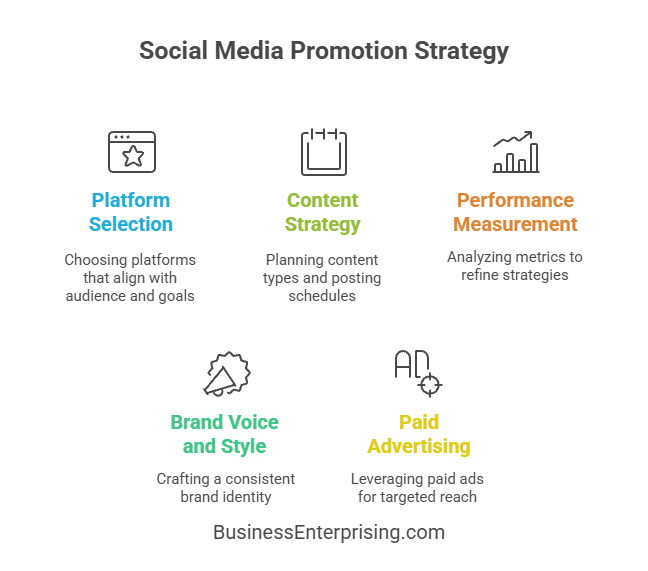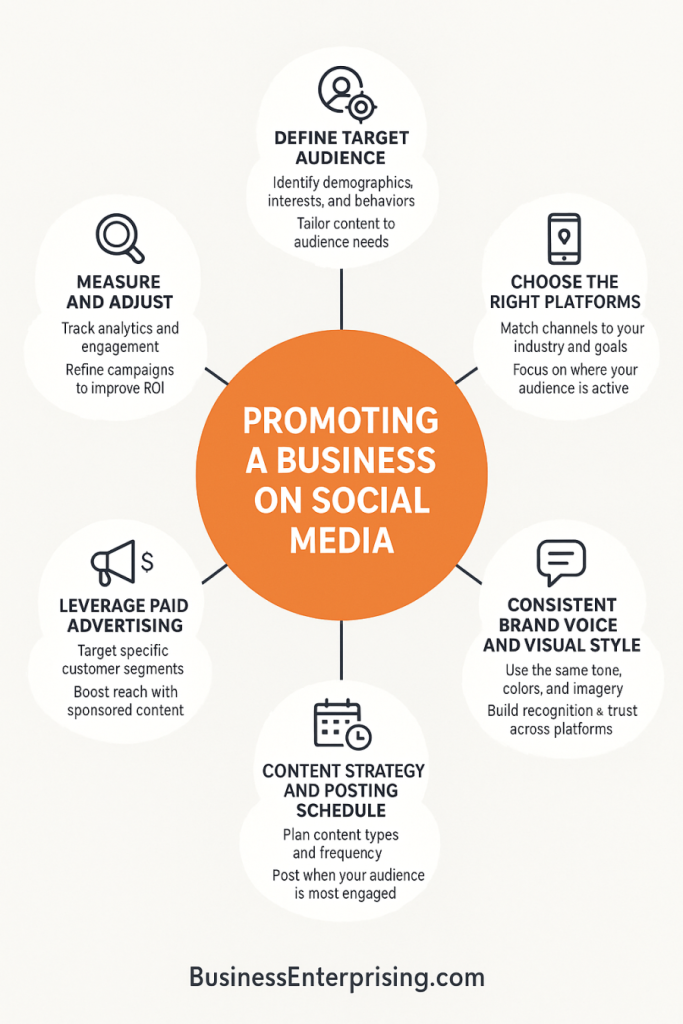 Promoting a business on social media offers you opportunities to reach more people and build stronger relationships with your audience. Success depends on making thoughtful choices about your approach. Therefore, you need to understand your audience, choose the right platforms, and maintain a consistent presence. A clear strategy helps you focus your time and resources where they will produce the best results.
Promoting a business on social media offers you opportunities to reach more people and build stronger relationships with your audience. Success depends on making thoughtful choices about your approach. Therefore, you need to understand your audience, choose the right platforms, and maintain a consistent presence. A clear strategy helps you focus your time and resources where they will produce the best results.
Additionally, effective social media promotion involves more than posting content regularly. You should create messages that reflect your brand’s personality and values. This helps your audience connect with you on a deeper level. Therefore, align your visuals, tone, and topics to create a cohesive experience across all platforms.
Timing, frequency, and format also play an important role. Therefore, pay attention to when your audience is most active and what types of content they prefer. Additionally, be willing to test new ideas and monitor performance to refine your approach. By reviewing your results often, you can make informed adjustments that improve engagement and reach.
Social media offers a competitive space where attention is limited. Therefore, planning your campaigns with intention and consistency increases your chances of standing out. Additionally, combining organic efforts with paid strategies can help you reach a broader audience. With a structured and adaptable plan, you can strengthen your brand presence and build lasting connections with your customers over time.
Defining Your Target Audience for Social Media Campaigns
Identifying your target audience is a key first step when promoting a business on social media. You need to know who you want to reach before creating content. Start by gathering basic demographic information such as age, gender, and location. This helps you focus your message where it will have the most impact. Additionally, learn about your audience’s interests and preferences so your posts align with what matters to them.
You can gain insight by observing the types of content your potential customers already engage with. Pay attention to the pages they follow, the hashtags they use, and the conversations they join. This information helps you understand the tone, style, and subjects that resonate. Therefore, you can adapt your messaging to match their expectations and keep them engaged over time.
Behavioral data is also important for shaping your approach. Track patterns like the times your audience is most active and the devices they use. This allows you to schedule posts when they are most likely to see them. Additionally, review engagement metrics regularly to identify what works and what needs to change. This way, your efforts remain focused and effective rather than relying on guesswork.
Defining your target audience is an ongoing process. People’s preferences and habits can shift, so you should revisit your research often. By staying connected to your audience’s needs and behaviors, you make your campaigns more relevant. Ultimately, understanding who you are speaking to helps you create content that encourages interaction and builds stronger connections over time.
Choosing the Right Social Media Platforms
Choosing the right social media platforms is an important decision when promoting a business on social media. Each channel has its own strengths and audience. You want to select platforms that align with your industry and marketing goals. For example, Instagram works well for visual products, while LinkedIn is effective for professional services.
Before committing to a platform, take time to understand where your target audience spends most of their time. Therefore, research the demographics and behaviors of users on each channel. Additionally, consider the type of content you create most effectively. Some platforms favor short videos, while others prioritize long-form posts or images. Matching your content style to the platform helps improve engagement.
You should also evaluate the resources needed to maintain a consistent presence. Some channels require frequent posting and active interaction to stay relevant. Therefore, choose platforms you can support with the time and effort available. Additionally, analyze what your competitors are doing successfully. This can offer insight into which platforms might give you better results.
Selecting the right platform mix often takes testing. You may need to try several options before seeing what performs best for your business. However, reviewing analytics regularly will help you refine your focus. By aligning your choice of platforms with your audience’s habits and your business goals, you create a stronger foundation for social media success. This targeted approach can help your marketing efforts produce meaningful connections and measurable growth over time.
Crafting a Consistent Brand Voice and Visual Style
A consistent brand voice and visual style is important for building recognition and trust when promoting a business on social media. Your audience should be able to identify your content instantly. This requires aligning your tone, messaging, and visuals across all platforms. Consistency helps create familiarity, which makes your brand more memorable over time.
Start by defining how you want to communicate with your audience. Therefore, decide on the tone that fits your brand, whether it is professional, friendly, or casual. Additionally, keep your language style uniform across captions, comments, and direct messages. This creates a cohesive experience for followers.
Your visual style is equally important. Use the same color palette, typography, and image style to create a recognizable look. Therefore, design templates for graphics and posts to maintain a uniform presentation. Additionally, choose imagery that reflects your brand values and resonates with your audience. This makes your content more appealing and recognizable in a crowded feed.
Consistency requires attention to detail and regular review. Therefore, audit your content periodically to confirm it aligns with your brand guidelines. Additionally, brief anyone creating content for you on your voice and style standards. By keeping your brand identity consistent across platforms, you reinforce trust and credibility. Over time, this recognition can help strengthen engagement and build a loyal community around your business.
Content Strategy and Posting Schedules
A clear content strategy and posting schedule can make a big difference when promoting a business on social media. Planning your content types, frequency, and timing helps you stay consistent and relevant. Therefore, you should start by deciding which types of content best match your goals. This might include images, videos, articles, or polls.
Additionally, think about how often you can post while maintaining quality. Posting too often can overwhelm your audience, while posting too little may cause them to lose interest. Therefore, find a balance that works for your resources and your followers’ expectations. You can adjust this frequency based on engagement trends and performance data.
Timing also plays a role in maximizing visibility. Your audience is more likely to engage when they see your content at the right time. Therefore, monitor when your followers are most active and schedule posts accordingly. Additionally, use these patterns to guide future posting decisions so your efforts remain targeted and effective.
Your content strategy should evolve over time. Regularly review analytics to identify which formats and posting times bring the best results. Additionally, refine your schedule to focus on what resonates most with your audience. By combining thoughtful content planning with consistent posting, you can increase engagement, strengthen your brand presence, and build a more loyal audience.
Leveraging Paid Advertising and Sponsored Posts
Paid advertising and sponsored posts can be powerful tools when promoting a business on social media. These methods allow you to target specific customer segments with precision. Therefore, you can focus your budget on reaching people who are most likely to engage with your brand. This targeted approach often delivers better results than broad, unfocused campaigns.
Before running ads, define your audience based on demographics, interests, and behaviors. Additionally, consider creating separate campaigns for different customer groups. This allows you to tailor messages and offers that appeal directly to each segment. Therefore, your ads feel more relevant and increase the likelihood of interaction.
The format and placement of your ads matter as well. Choose between image, video, carousel, or story formats based on your content style. Additionally, test various headlines and visuals to see what attracts the most clicks or engagement. This testing process helps refine your approach over time and improves the efficiency of your ad spend.
Monitoring performance is essential for success. Therefore, review metrics such as click-through rates, impressions, and conversions regularly. Adjust your targeting, creative elements, or budget as needed. By using paid advertising strategically, you can boost brand awareness, drive traffic, and generate more leads. Over time, this approach can complement your organic efforts and help you build a stronger presence on social media.
Measuring Performance and Adjusting Strategies
Measuring performance is essential for refining your approach when promoting a business on social media. Tracking analytics helps you understand what is working and what needs improvement. Therefore, review metrics like engagement, reach, and conversions regularly. This gives you a clearer view of how your audience interacts with your content.
Additionally, compare results over time to identify patterns. Certain post types or topics may consistently perform better than others. Therefore, focus more resources on the formats and messages that generate the strongest responses. Adjusting your strategy based on this data helps you use your time and budget more effectively.
It is also important to evaluate the timing of your posts. Analytics can reveal when your audience is most active and responsive. Therefore, schedule your content during these peak periods to increase visibility. Additionally, experiment with different posting times and track changes in engagement.
Refining your campaigns should be an ongoing process. Review your results regularly, and do not hesitate to make adjustments. Therefore, test new ideas alongside proven tactics to keep your content fresh while building on past successes. By using analytics to guide your decisions, you improve your return on investment and create more impactful campaigns over time.
Conclusion
Promoting a business on social media requires a well-planned approach that aligns with your goals and audience. Every decision, from choosing platforms to refining strategies, plays a role in your success. Therefore, you should focus on building a strong foundation with a clear brand voice, consistent visuals, and relevant messaging.
Additionally, keeping your audience’s preferences in mind will help you create content that resonates and encourages engagement. This means adjusting your approach as trends shift and new opportunities arise. Therefore, use analytics regularly to identify which efforts are driving results and which need improvement.
Paid advertising can also complement your organic efforts when used strategically. By targeting the right segments, you can increase visibility and reach people most interested in your offerings. Additionally, testing new formats and creative ideas can reveal fresh ways to connect with potential customers.
Consistency, attention to detail, and a willingness to adapt are key to sustaining growth over time. Therefore, review your performance often and refine your approach to keep your campaigns effective. By combining strategic planning with ongoing evaluation, you can strengthen your presence and create meaningful connections with your audience. Over time, this process can lead to stronger brand recognition, higher engagement, and measurable business growth.






